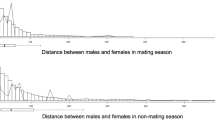Abstract
Evidence is reviewed that female Japanese macaques have multiple male mating partners when they are available and show a preference for mating with sexually unfamiliar males. Several lines of evidence suggest that this aspect of female sexual behavior results in the offspring of an individual female being sired by more than one male thereby maintaining the genetic diversity of the troop. Evidence is presented in this paper that a decrease in the number of adult troop males and a lack of extra-troop migrant males in the Arashiyama West troop of Japanese macaques following transplantation to a ranch in south Texas had consequences for the sexual behavior of the females.
Similar content being viewed by others
References
Altmann J., 1974.Observational study of behavior: sampling methods. Behavior, 49: 227–267.
Berenstain L., Rodman P.S. &Smith D. G., 1981.Social relations between fathers and offsping in a captive group of rhesus monkeys (macaca mulatta). Animal Behavior, 29: 1057–1063.
Eaton G.G., 1978.Longitudinal studies of sexual behavior in the Oregon troop of Japanese macaques. In (T. E. Mcgill, D. A. Dewsbury, & B. D. Sachs Eds) Sex and Behavior, pp. 35–59. Plenum: New York.
Fedigan L. &Gouzoules H., 1978.The consort relationship in a troop of Japanese monkeys. IPartner Selection. In (D.J. Chivers Ed) Proceedings of the Sixth Int. Congress Primatology. pp. 493–495. London: Academic Press Inc.
Fedigan L.M., Gouzoules H. &Gouzoules S., 1983.Population dynamics of Arashiyama West Japanese macaques. International Journal of Primatology, 4(3): 307–321.
Gouzoules H. &Goy R.W. 1983.Physiological and social influences on mounting behavior of troop-living female monkeys (Macaca fuscata). American Journal of Primatology 5: 39–49.
Hanby J., 1972.The sociosexual nature of mounting and related behaviors in a confined troop of Japanese macaques. Dissertation, University of Oregon.
Hanby J., Robertson L. &Phoenix C., 1971.The Sexual Behavior of a Confined Troop of japanese Macaques. Folia Primatologica. 16: 123–143.
Hazama N., 1964.Weighing wild Japanese monkeys in Arashiyama. Primates. 5 (3–4): 81–104.
Itani J., 1972.A preliminary essay on the relationship between social organization and incest avoidance in nonhuman primates. In (F. Poirier, Ed.), Primate Socialization, pp. 165–171, New York: Random House.
Koyama N., 1967.On dominance rank and kinship of a wild Japanese monkey troop in Arashiyama. Primates, 8: 189–216.
Koyama N., 1970.Change in dominance rank and division of a wild Japanese monkey troop in Arashiyama. Primates, 11: 335–390.
Koyama N., Norikoshi K. &Mano T. 1975.Population dynamics of Japanese monkeys of Arashiyama In (S. Kondo, M. Kawai, & A. Ehara, Eds), Contemporary Primatology, pp. 411–417 Basel: S. Karger.
Kurland J. A., 1977.Kin Selection in the Japanese Monkey. Basel: S. Karger.
Lindburg D. G., 1969.Rhesus Monkeys: Mating season mobility of adult males. Science, 166: 1776–1778.
Melnick D. J., Pearl M. C. &Richard A. F., 1984.Male migration and inbreeding avoidance in wild rhesus monkeys American Journal of Primatology, 7(3): 229–243.
Murray R., 1980.The Evolution and functional significance of incest avoidance. Journal of Human Evolution, 9: 173–178.
Murray R. & Smith E., 1983.The role of dominance and intrafamilial bonding in the avoidance of close inbreeding. Journal of Human Evolution, 12: 000-000.
Nakatsuru K. &Kramer D., 1982.Is sperm cheap? Limited male fertility and female choice in the lemon Tetra (Pisces, Characidae). Science, 216: 753–754.
Ober C., Olivier T. J., Sade D. S., Schneider J. M., Cheverud J. &Buettner-Janusch J., 1984.Demographic components of gene frequency change in free-ranging macaques on Cayo Santiago. American Journal of Physical Anthropology 64(3): 223–231.
Parker C., 1979.Inter-troop transfer and inbreeding avoidance in Papio anubis. Animal Behavior, 27(1): 1–36.
Ralls K, &Ballou J., 1982.Effects of inbreeding on infant mortality in captive primates. International Journal of Primatology 3(4), 491–505.
Ripley S., 1980.Infanticide in langurs and man: adaptive advantage or social pathology? In (M. Cohen, R. Malpass, & H. Klein, Eds), Biosocial Mechanisms of Population Regulation, pp. 349–390. New Haven: Yale University Press.
Small M., 1983.Females without infants: mating strategies in two species of captive macaques. Folia Primatologica, 40: 125–133.
Smith D. G., Small M. F. &Rolfs B. K., 1985.Deleterious effects of close inbreeding in three captive groups of rhesus macaques. American Journal of Physical Anthropology 66(2), 229.
Stern B.R. &Smith D. G., 1984.Sexual Behaviour and Paternity in three captive groups of rhesus monkeys (Macaca mulatta). Animal Behavior, 32: 23–32.
Takahata Y., 1980.The reproductive biology of a free-ranging troop of Japanese monkeys. Primates, 21(3): 303–329.
Takahata Y., 1982a.Social relations between adult males and females of Japanese monkeys in the Arashiyam B troop Primates, 23(1): 1–23.
Takahata Y., 1982b.The Socio-Sexual Behavior of Japanese Monkeys. Z. Tierpsychol., 59: 89–108.
Werren J. H., Gross M. R. &Shine R., 1980.Paternity and the evolution of male parental care. Journal of Theoretical Biology, 82: 619–630.
Wilson, M., Gordon T. &Chikazawa D., 1982.Female mating relationships in Rhesus monkeys. American Journal of Primatology, 2(19): 21–28.
Wolfe L. D., 1974.The sexual behavior of the Arashiyama West troop of Japanese macaques. Presented at the American Anthropology Association Annual Meetings.
Wolfe L. D., 1979.Behavioral patterns of estrous females of the Arashiyama West troop of Japanese macaques (Macaca fuscata). Primates, 20(4): 525–534.
Wolfe L. D., 1981a.Display behavior of three troops of Japanese monkeys. Primates, 22(18): 24–32.
Wolfe L. D., 1984.Japanese macaque female sexual behavior: a comparison of Arashiyama B and West. In (M. Small, Ed), Studies of Primate Female Behavior, pp. 141–157. New York: Alan R. Liss.
Author information
Authors and Affiliations
Rights and permissions
About this article
Cite this article
Wolfe, L.D. Sexual strategies of female Japanese macaques (Macaca fuscata). Hum. Evol. 1, 267–275 (1986). https://doi.org/10.1007/BF02436584
Received:
Accepted:
Issue Date:
DOI: https://doi.org/10.1007/BF02436584




